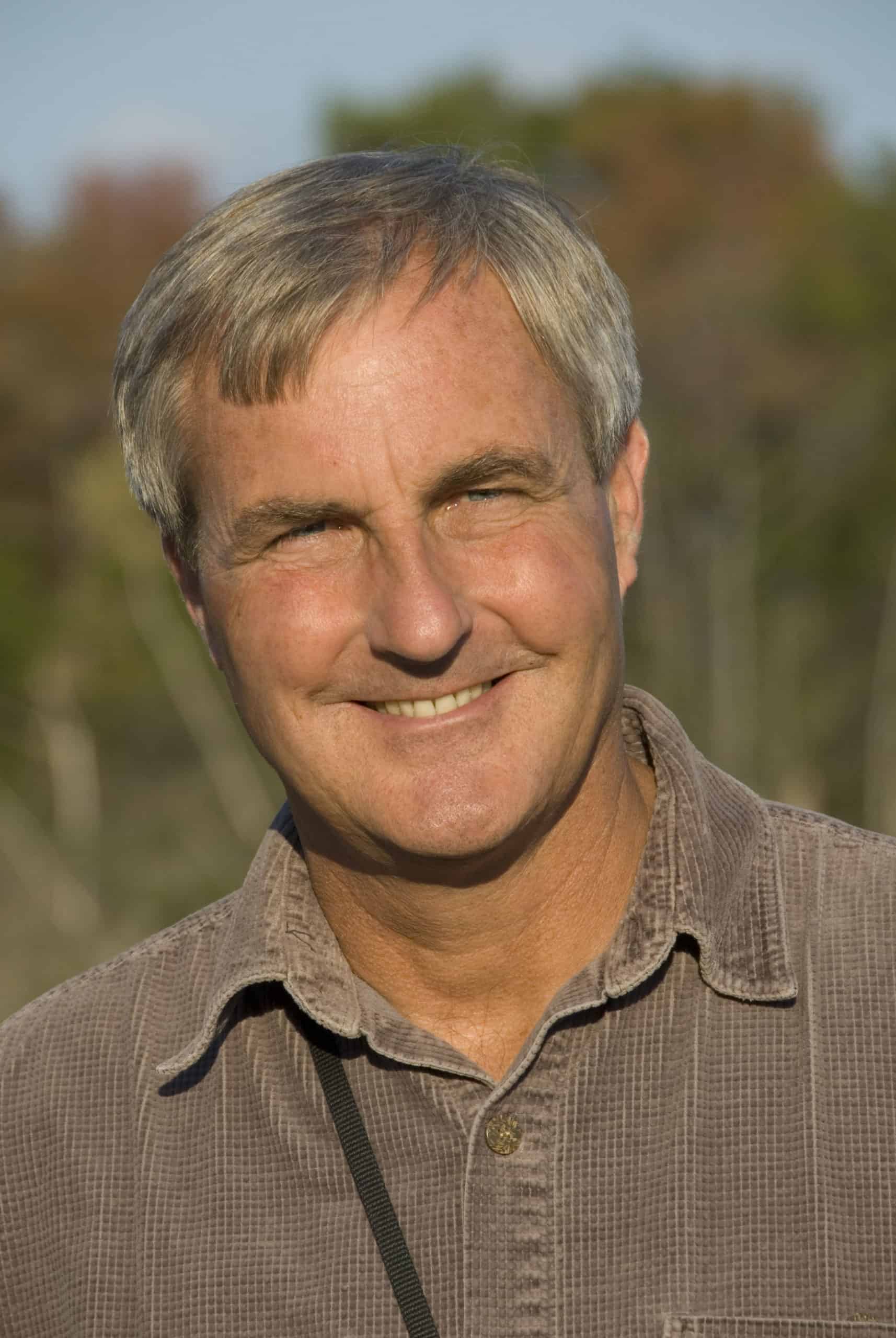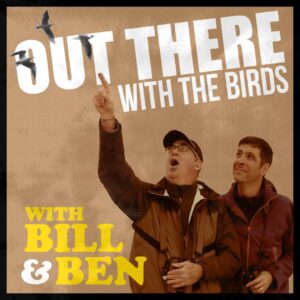This past January, Editor Dawn Hewitt was invited to speak on the legacy of Bird Watcher’s Digest at the Space Coast Birding and Wildlife Festival. Here is Part 2 of her talk. You can find Part 1 here. Stay tuned for the next installment continuing the story!
Noteworthy Contributors
I would be remiss if I didn’t mention some of the noteworthy contributors to the 249 issues published since September/October 1978. Even before the first anniversary issue of BWD, original content started showing up on our pages. And it kept growing. Soon, reprints were few and far between as more and more birders, including some famous names, wanted a byline in BWD.
In the January/February 1980 issue, BWD published an excerpt from Roger Tory Peterson’s book Penguins. Peterson jumped on board in January/February 1982 as senior advisor, and soon asked if he could write a column for each issue! In Jan/Feb 1984, RTP’s column debuted, and was eventually titled All Things Reconsidered, which ran through the September/October 1996 issue.
Other early, notable contributors included Don and Lilian Stokes, who debuted their column, The Behavior Watcher’s Notebook, in March/April 1982—the earliest standing column in BWD. Their column continued through the March/April 1985 issue.

Pete Dunne’s byline first appeared in the March/April 1979 issue of BWD, for a story titled “Birding at Cape May,” reprinted from New Jersey Audubon Magazine. Apparently, Mary Beacom Bowers liked Pete’s writing, because his byline appeared two or three times per year (remember, BWD publishes only six times per year) through March/April 1985, when Pete’s Close Focus column debuted. That column ran for only four years, but even after it ended, we still ran one story by Pete every year or so for more than a decade. Then, in 2016, Pete asked me if he could resume writing a column for BWD. I was THRILLED—I still am—to publish Pete’s Tip in each issue of BWD.
Did you know that former President Jimmy Carter wrote a story for BWD? In March/April 1991, we ran a story about how the former first couple, Jimmy and Rosalyn Carter, had taken up birding in a big way. Included were two reports from bird guides the Carters had hired during their travels. And in the September/October 2004 issue, Jimmy Carter penned a story for BWD titled “The Remarkable Rio Grande Valley.”
In the same issue, Kenn Kaufman’s byline debuted, and he wrote many stories for us until January/February 1995, when he penned his first After the Spark column. That column ran for 20 years, and then began Scott Weidensaul’s Migrations column, which still runs.
In the first decade of the new millennium, before he became president of the American Birding Association, Jeff Gordon wrote lots of stories for BWD, including a stint as the Identify Yourself columnist, which Alvaro Jaramillo now pens.

And, of course, Julie Zickefoose. Her first story for us was published in the May/June 1988 issue, although we used one of her paintings, of a ruby-crowned kinglet, for the first time on the cover of the November/December 1986 issue. Julie wrote lots of stories for BWD in the late 1980s and throughout the ’90s and early 2000s, and with the September/October 2008 issue, Julie’s True Nature column launched—that was the 30th anniversary issue. Her column still runs in every issue, and Julie’s art has appeared on our cover 30 times, more than any other artist.
Many readers think Julie is on the staff of BWD. She is not, and never has been. She’s a freelance writer and artist, a paid columnist, and a loyal friend and supporter of BWD, but she is not on the regular payroll. None of our columnists are—they’re freelance writers, and beloved friends.
When Bill became editor of BWD, he hired managing editors to assemble the content of the magazine, working with the columnists, freelance writers, and photographers. That’s what I was hired to do in October 2013. I remain proud of the content of BWD. We tell great stories about birds, birders, bird watching, birding adventures, and birding destinations. We tell stories like no other magazine out there. (Sometimes, the stories are a bit quirky!) Plus, we fit in your handbag! (That’s something many, many people tell us they love about BWD.)

More Than a Magazine
Of course, the No. 1 legacy of the Thompson family is Bird Watcher’s Digest, our flagship. But BWD is more than a magazine. Oh boy, are we ever!
Actually, we publish two magazines. Watching Backyard Birds comes out in months alternating with BWD. It is the only publication in North America that focuses entirely on backyard birds, for those whose interest in birds is primarily close to home. Both magazines are available in print or digitally. That’s right: You can subscribe to our magazines, and if you want, no trees will be harmed! Digital subscriptions cost less! However, if you subscribe to the print edition of either magazine, access to the digital edition is free.
Watching Backyard Birds is smaller, and maybe slightly lighter weight than BWD. It typically includes helpful advice for attracting birds to one’s backyard, backyard bird species profiles, useful how-to ideas, examples of backyard landscaping for birds, and how it varies across the continent, and information that aims to help readers better enjoy their backyard birds. There’s always at least one article by Julie Zickefoose, and a backyard-bird Q-and-A column written by BirdSquatch, a figment of BT3’s slightly warped imagination. BirdSquatch continues to get questions from readers!

We also produce a twice-monthly e-connection for better birding, called BirdWire. We used to call it a newsletter, but it’s not so much newsy, but information-packed, including timely articles about what’s going on right now in the world of birds, such as what’s migrating through, or how to help nesting birds. Sometimes there are bird ID or trivia quizzes. It’s free! So, BWD, WBB, and BirdWire are our three published periodicals. All three are available digitally, but BWD and WBB are also in print.
Over the years, BT3 wrote a bunch of books, including The Dummy’s Guide to Bird Watching, Bird Homes and Habitats, Butterflies and Hummingbirds (co-written with Connie Toops), and a whole series of books on birding by state, and another series on backyard birding by region. He also wrote The Young Birder’s Guide and The New Birder’s Guide, both of which were in the Peterson Field Guide series.
Also, BWD publishes a series of booklets with titles including Enjoying Cardinals More, Enjoying Woodpeckers More, A Backyard Bird ID Guide, Birding Basics and Beyond; Enjoying Squirrels More (or Less)—which Jimmy Fallon shared on his show because he thought the title was funny. We sold those books wholesale to WalMart for several years, and we still sell them wholesale to Wild Birds Unlimited stores as well as to independent wild bird-feeding stores.
And then, there’s our website. BWD established birdwatchersdigest.com in 1999, but it really wasn’t a major focus for outreach or content until 2004, when we revamped it to allow online subscriptions, to help with customer service, and to provide information and self-help for bird watchers. That website has grown into a massive repository of content about birds, including ID help, regional birding advice for traveling birders, answers to frequently asked questions, tips on attracting birds, and tons more. We host birding pages for all 50 states—hotspots, festivals, links to birding clubs, state email lists, and other state-specific birding resources, etc., which we are continually adding to.
We are serious about online content, and we spend a lot of time and effort developing and expanding an engaging online presence, not only from our website, but though online marketing, email lists, social media, and more. I encourage you to friend us on Facebook or Instagram. We are very active on social media—and its mostly not advertising: It’s about birds and birding. Inspirational, informative, sometime humorous stuff, and often interactive, so there’s a sharing that’s part of building the birding community.
We have a YouTube channel with helpful videos, and some silly videos, too. BT3 was a notorious cleaner of binoculars. At festivals and on tours, he always offered to clean and evaluate other people’s binoculars. It was his way, I think, of washing the feet of other birders. I mean, here is this famous A-list birder, eager to offer this kindness to other birders. One of our YouTube videos is BT3 on how to clean your binoculars.
In September 2005, BT3 started a blog, called Bill of the Birds. He was such an amazing storyteller and through the years posted more than 1,000 times. Lots of people who never met Bill or even heard him speak began following billofthebirds.blogspot.com, and developed a connection to him, and to his family. His writing was so friendly that they felt that they were his friends even if they were barely acquaintances. He was just so warm and welcoming.

In early 2007, Bill dipped his toe into the world of podcasting with the debut of This Birding Life, in which, primarily, he interviewed noteworthy birders, often while he was on a birding adventure. Thousands of people subscribed to this podcast, and apparently hung on his every word. People who had never subscribed to Bird Watcher’s Digest subscribed to This Birding Life because it was just that good. He recorded 89 episodes of that podcast, and the last couple were recorded when he knew he wouldn’t be around much longer. One of the final episodes, with ABA President Jeff Gordon and his wife Liz Gordon, who were decades-long friends of Bill, is particularly poignant. If ever you need a good cry, track down that episode. But if you need a good laugh, or just want to hear an interesting story about a birding adventure, or an interview with a world-class birder, then listen to all 89 episodes. Not kidding. Load up your podcasting app and drive a thousand miles. You’ll be entertained the whole way.

Bill started another blog for Bird Watcher’s Digest—this one with multiple authors, myself included—and another podcast channel, called Out There with the Birds. The OTWTB podcast began with BT3 and Ben Lizdas discussing birds, life, music, technology, birding trips—all sorts of topics. It was like sitting in on a conversation between two interesting friends of yours, and it, too, became very popular. It has evolved since Bill’s death, but I hope you will check it out.



